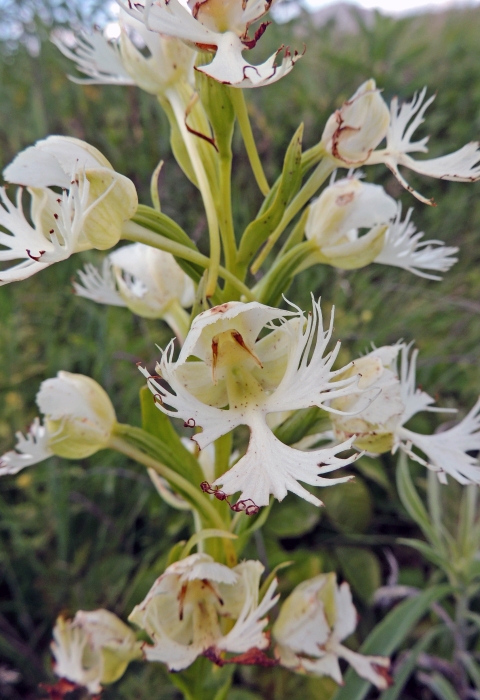Overview
The western prairie fringed orchid is federally protected under the Endangered Species Act as a threatened species. It is a member of the orchid family and is found in moist tallgrass prairies in Iowa, Kansas, Minnesota, Missouri, Nebraska, North Dakota, and Manitoba, Canada. The species appears to be extirpated from Oklahoma and South Dakota. The largest populations are found in North Dakota, Minnesota and Manitoba, Canada.
Main threats to the species include the conversion of remnant prairie to cropland, incompatible use of herbicides and pesticides, siltation, changes in hydrology, fire suppression, encroaching woody vegetation, and the spread of non-native, invasive plant species. Heavy grazing and early haying may also have detrimental impacts on populations (USFWS 2021, p. 12). Protecting known populations, applying prescribed burns and other activities are necessary to keep this orchid on the landscape.
Scientific Name
Identification Numbers
Characteristics
Habitat
The western prairie fringed orchid occurs in moist tallgrass prairies and sedge meadows. In North Dakota, it is commonly found with sedges, reedgrass, and rushes or where those plants meet big bluestem, little bluestem, and switchgrass. The western prairie fringed orchid is well adapted to survive fires. Light grazing does not appear to negatively affect the western prairie fringed orchid, although researchers are still studying the relationship.
Ecosystem with large, flat areas of grasses.
Life Cycle
The western prairie fringed orchid is distinguished by large, creamy white flowers that come from a single stem. Up to 24 flowers may occur on a single plant. The flower is fringed on the margins, giving it a feathery appearance. Plants have 2 to 5 thick, narrow leaves that hug the stem (USFWS 1996, p.1).
The western prairie fringed orchid is a perennial; however, differences exist between North Dakota and Minnesota populations in how long an individual plant lives. In North Dakota, most plants live 3 years or less and show higher rates of mortality than Minnesota plants (USFWS 1996, p. 9).
The nocturnally fragrant flowers of these perennial orchids attract hawkmoths that feed on nectar and transfer pollen from flower to flower and plant to plant. Seed germination and proper plant growth depend on a symbiotic relationship between the plants' reduced root systems and a soil-inhabiting fungus for proper water uptake and nutrition.
Physical Characteristics
The western prairie fringed orchid is distinguished by large, creamy white flowers that come from a single stem. Up to 24 flowers may occur on a single plant. The flower is fringed on the margins, giving it a feathery appearance. Plants have 2 to 5 thick, narrow leaves that hug the stem (USFWS 1996, p.1).
Western prairie fringed orchids produce flower stalks up to 4 feet (1.19 meters) tall. Each stalk has up to 40 flowers each about an inch (2.5 centimeters) long (USFWS 1996, p. 1).
The western prairie fringed orchid occurs in moderately moist (mesic) tallgrass prairies and sedge meadows with level or gently sloping topography. The species may also be found in old fields and roadside ditches (USFWS 1996, p. 4). In North Dakota, it is commonly found with sedges, reedgrass, and rushes or where those plants meet big bluestem, little bluestem, and switchgrass. Western prairie fringed orchids rely on specific soil fungi for seedling establishment and plant growth.
Similar Species
The eastern prairie fringed orchid is similar to the western prairie fringed orchid; however, it primarily inhabits areas east of the Mississippi River. The eastern prairie fringed orchid is also listed as a threatened plant.
Geography
The western prairie fringed orchid is restricted to west of the Mississippi River and currently occurs in Iowa, Kansas, Minnesota, Nebraska, North Dakota, and in Manitoba, Canada.
Timeline
Explore the information available for this taxon's timeline. You can select an event on the timeline to view more information, or cycle through the content available in the carousel below.
6 Items